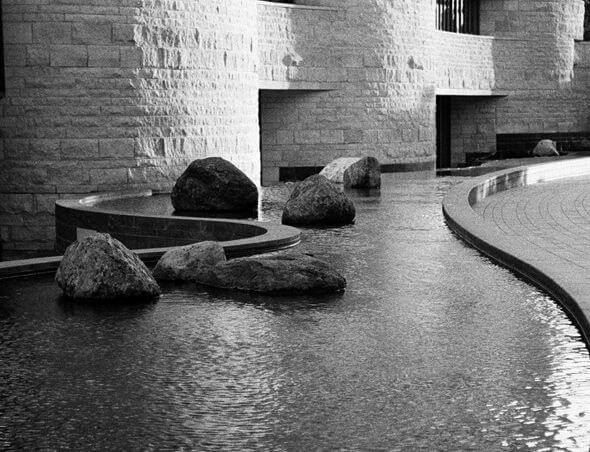
As fountain consultants, we are often asked about waterproofing fountain basins. While we (and most landscape architects) are not able to specify waterproofing due to insurance requirements, there are a number of things to consider when you have to waterproof a fountain basin and all of the piping entering and exiting the structure.
The first place to start is with the structure itself. We recommend that the structural engineer specify the fountain basin concrete to 4500 psi strength. This is a durable concrete mix that will work well in freeze thaw areas and beyond.
For years, and during the time that I was a fountain contractor, we used topical waterproofing over concrete structural floors and walls. These types of waterproofing range from cementitious to fluid applied rubber, urethanes, epoxies and polymers. All of these products can be successful if properly applied, but they can also be difficult to repair if improperly installed. If you have a basin with topical waterproofing and it is leaking, it is almost impossible to know where the leak is, especially if there are finishes in the fountain.
The most important aspect of installing a topical waterproofing is the preparation of the substrate to achieve complete adhesion. The fountain concrete must be completely clean of dirt, dust, debris and oils prior to installation, which can be a challenge on an active job site. Special care and detailing for these products are required at all cold joints and movement joints. If the fountain does not have any finishes in it, you have to pick a product that will not only be resistant to sunlight and UV, but also that looks acceptable both with water in it and empty. Care should be taken to not install the waterproofing too soon as moisture escaping from curing concrete can affect the adhesion of the waterproofing.
If the fountain is to receive finishes like tile or stone veneers, then it is incumbent on the specifier, the general contractor, and waterproofing contractor to protect the newly installed waterproofing while the stone masons and plumbers are working in the pool. The specifier (either the architect or landscape architect) should also make sure that whatever finish and mortars they have specified are compatible with the waterproofing from an adhesion standpoint. We have seen many finishes fail due to lack of proper adhesion between cementitious mortars and epoxy or polymeric waterproofing materials.
About 20 years ago we looked into cementitious admixtures that are added to the concrete at the batch plant and make the concrete inherently waterproof. These products are used extensively on parking structures in cold climates and have a good record of durability and longevity. We have now almost exclusively gone to recommending waterproof admixtures rather than topical waterproofing. These products differ on how they work as some become active when water penetrates the concrete and others are hydrophobic and retard water from entering. We have had good success with a product called Hycrete system W, but there are others which are worth mentioning, including Caltite, Xypex, and Aquafin.
We have had instances where the owner wants a belt and suspenders approach and asks for both an admixture and topical waterproofing. For topical waterproofing we lean toward cementitious products like Thoroseal or Aquafin, especially when there are finishes involved. Again, these are recommendations to the architect to specify. Fluid applied waterproofing products include Neogard, CIM, and Tnemec.
What if?
So, what if you have a project with no Architect to specify the waterproofing? First, ask the structural engineer to specify waterproof concrete. If you need to specify a topical waterproofing you can include a product from Laticrete in your grout and mortar specification in Div 4. Laticrete makes a product called 9235 that is compatible with its grout and mortars that you can include as a complete system in a Div 4 specification.
Do not forget to use waterstops on all cold joints, movement joints, and pipes. Read about them and water feature liners in a future installment.
